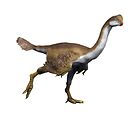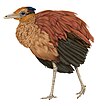近頜龍屬
| 近颌龙属 化石时期:晚白垩世,
| |
|---|---|

| |
| 柯氏近颌龙(左)与斯氏近颌龙(右)的颌骨 | |
| 科学分类 | |
| 界: | 动物界 Animalia |
| 门: | 脊索动物门 Chordata |
| 纲: | 蜥形纲 Sauropsida |
| 总目: | 恐龍總目 Dinosauria |
| 目: | 蜥臀目 Saurischia |
| 亚目: | 獸腳亞目 Theropoda |
| 总科: | †近頜龍超科 Caenagnathoidea |
| 科: | †近颌龙科 Caenagnathidae |
| 亚科: | †近颌龙亚科 Caenagnathinae |
| 属: | †近颌龙属 Caenagnathus Sternberg, 1940 |
| 模式種 | |
| †柯氏近颌龙 Caenagnathus collinsi Sternberg, 1940
| |
近颌龙(属名:Caenagnathus,意为“最近的颌”)是一属近颌龙科偷蛋龙类恐龙,生存于白垩纪晚期的坎帕阶(约7500万年前),化石包括下颚、尾椎骨、手骨和后肢在内的部分遗骸,发现于加拿大亚伯达省的恐龙公园组。该属重约96公斤(212磅)。[1]
叙述
[编辑]近颌龙是一种大型偷蛋龙类,化石表明该属的大小相当于它的亲戚安祖龙。像安祖龙一样,它的下喙没有牙齿,而且比单足龙亚科更浅。它与安祖龙的比例也比后者更小。[2]它很可能拥有一层羽毛,就像所有的偷蛋龙类一样。[1]
分类学
[编辑]这种恐龙有着混乱的分类历史。1936年,人们发现了一些颌骨(CMN 8776)并命名为近颌龙,意思是“最近的颌骨”;该属最初被认为是一种鸟。[3]1988年,人们研究了一个自1923年以来就已发现的标本(现在命名为后纤手龙)并将它分配给纤手龙属――一个只有化石碎片的偷蛋龙类物种。它最初是根据一双前肢命名的,这双前肢长期以来被认为是来自一只近颌龙。由于这些遗骸的第一个名字是“纤手龙”,因此这也是多年来唯一被认为有效的名称。[4]然而,Senter和Parrish(2005年)怀疑近颌龙是纤手龙的异名,指出后纤手龙模式标本中的上颌遗骸与CMN 8776没有重叠。Senter(2007年)对近颌龙的研究中发现该属属于近颌龙超科,而纤手龙则属于一个与单足龙亚科相关的衍生进化支。[5][6]
随着2014年和2015年更完整标本的发现,近颌龙与其他近颌龙超科的关系的争议开始得到解决。2014年对安祖龙的描述中确立了第一个化石几乎完整的近颌龙科,有助于澄清零碎标本之间的差异。系统发育分析发现,与纤手龙相比,该属与安祖龙的亲缘关系更近。在2014年的一次分析中,第二个物种(之前被称为“斯氏近颌龙”)被发现是安祖龙和近颌龙的姊妹分类单元。[7]2015年,新的化石残骸被发现,并归类于柯氏近颌龙。这种动物在大小和解剖结构上介于小型的纤手龙和大型的安祖龙之间――这为它们的假设关系提供了支持。根据四肢的特征(特别是手和跖骨),这些骨骼可以与纤手龙和生存于同一时期的细喙龙区别开来。[1]
| 近颌龙超科 Caenagnathoidea |
| |||||||||||||||||||||||||||||||||||||||||||||
Funston和Currie(2020年)描述的一个新的纤手龙标本保存了下颌骨,这为证明近颌龙属的有效性提供了进一步的证据,表明尽管这两个分类群都是近颌龙科的一部分,但近颌龙是一个不同于纤手龙的属。[8]
参考资料
[编辑]- ^ 1.0 1.1 1.2 Funston, G. F.; Persons, W. S.; Bradley, G. J.; Currie, P. J. New material of the large-bodied caenagnathid Caenagnathus collinsi from the Dinosaur Park Formation of Alberta, Canada. Cretaceous Research. 2015, 54: 179–187. doi:10.1016/j.cretres.2014.12.002.
- ^ Funston, Gregory. Caenagnathids of the Dinosaur Park Formation (Campanian) of Alberta, Canada: anatomy, osteohistology, taxonomy, and evolution. Vertebrate Anatomy Morphology Palaeontology. 2020-07-27, 8: 105–153. ISSN 2292-1389. doi:10.18435/vamp29362.
- ^ Sternberg, R.M. A toothless bird from the Cretaceous of Alberta. Journal of Paleontology. 1940, 14 (1): 81–85.
- ^ Currie, P.J.; Russell, D.A. Osteology and relationships of Chirostenotes pergracilis (Saurischia, Theropoda) from the Judith River (Oldman) Formation of Alberta, Canada. Canadian Journal of Earth Sciences. 1988, 25: 972–986. doi:10.1139/e88-097.
- ^ Senter, P.; Parrish, J.M. Functional analysis of the hands of the theropod dinosaur Chirostenotes pergracilis: evidence for an unusual paleoecological role. PaleoBios. 2005, 25: 9–19.
- ^ Senter, P (2007). "A new look at the phylogeny of Coelurosauria (Dinosauria: Theropoda)". Journal of Systematic Palaeontology. 5 (4): 429–463. doi:10.1017/s1477201907002143.
- ^ Lamanna, M. C.; Sues, H. D.; Schachner, E. R.; Lyson, T. R. A New Large-Bodied Oviraptorosaurian Theropod Dinosaur from the Latest Cretaceous of Western North America. PLoS ONE. 2014, 9 (3): e92022. PMC 3960162
 . PMID 24647078. doi:10.1371/journal.pone.0092022.
. PMID 24647078. doi:10.1371/journal.pone.0092022.
- ^ G. F. Funston & P. J. Currie (2020) New material of Chirostenotes pergracilis (Theropoda, Oviraptorosauria) from the Campanian Dinosaur Park Formation of Alberta, Canada, Historical Biology, doi:10.1080/08912963.2020.1726908
- Cracraft, J. Caenagnathiformes: Cretaceous birds convergent in jaw mechanism to dicynodont reptiles. Journal of Paleontology. 1971, 45: 805–809.
- Sues, H.D. On Chirostenotes, a Late Cretaceous oviraptorosaur (Dinosauria: Theropoda) from Western North America. Journal of Vertebrate Paleontology. 1997, 17 (4): 698–716. doi:10.1080/02724634.1997.10011018.























